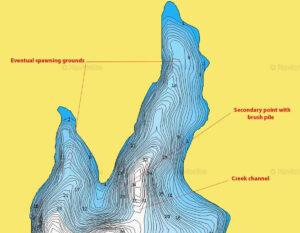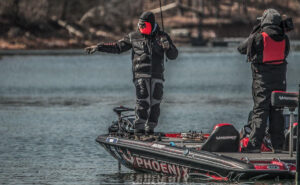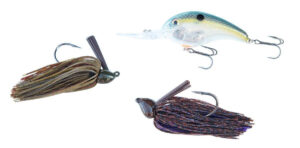A large percentage of the country’s more popular bass fishing reservoirs were built following the Great Depression of the 1920s and 1930s. Although these fisheries once resembled flooded forests full of textbook bass-holding cover and structure, 60-plus years of constant water fluctuation and exposure to the natural elements has taken its toll on the timber in which bass are known to inhabit.
As a result of this inevitable change, many bass anglers have taken matters into their own hands by distributing brush piles, or dead trees, throughout their local reservoirs—especially in the past 20 years. In the big picture of bass fishing, dissecting and targeting brush piles could certainly be considered a fairly new endeavor.
Elite Series pro and 2014 Bassmaster Angler of the Year Greg Hackney believes fishing these brush piles is an outstanding technique for catching big prespawn bass. As the egg-bearing females prepare their bodies for a strenuous spawning period, they’ll often use brush as strategic ambush points as they fill their bellies with much needed nutrients.
In order to maximize your success and improve your odds of catching your fish of a lifetime, Hackney believes there are several things you need to know.
- Two primary advantages
- Location is everything
- Conditions can change fish positioning
- The biggest bass prefer isolated brush
- Slow and steady to avoid hang-ups
- Patterning by depth
- High-percentage baits
Concentration points and a physical reference
Before you start hunting for that “magical” brush pile on your favorite fishery, it’s important to understand why they’re so special throughout the prespawn period. According to Hackney, they offer anglers two critical advantages.
- Concentration— “If you’re fishing a specific piece of structure like a flat or point, the bass could be anywhere,” Hackney said. “You might have to cast around for a while before you get an idea of their relative location. But when you add a brush pile to that area, that’s when it gets easier. It will concentrate the nearby bass into a very concise and predictable area.”
- Physical reference— Hackney draws some compelling parallels between prespawn brush pile fishing and bed fishing during the spawn. Much like bass beds, this brush gives anglers a definitive target to cast towards, which not only increases confidence, but also repeatedly puts your bait of choice in the most productive strike zone. There’s no guesswork involved—you know you’re in “the juice” on each and every cast. And similar to bed fishing, you might have to make repeated casts in order to entice a bite, but he believes it’s just a matter of time before you irritate them into biting.
Location, location, location
There’s a common misconception among anglers in regards to brush pile fishing. Many of us believe that, when we find a brush pile, we’ve found the bass. Unfortunately, that’s not necessarily the case. You might catch a fish or two on a random pile, but the most productive brush will be found in very strategic locations.
- Secondary points— As days get longer and water temperatures rise, bass leave their wintering holes and begin their migration to their spawning grounds. They’ll use creek channels in the same manner as humans use highways and secondary points are an ideal “rest area” during their early spring pilgrimage. If Hackney finds a brush pile with his Garmin on or near one of these secondary points, he considers it an ideal spot to catch a big, female prespawner because it’s most likely the last piece of cover in a pocket before the shallow spawning flats.
- Depth— “The optimal depth is going to change depending on water clarity,” Hackney said. “On clearer reservoirs, you’ll find some of the best prespawn piles in 15 to 25 feet of water for two reasons—the bass will live a bit deeper and savvy fishermen don’t want other anglers finding their brush. If your fishery has fairly stained water, you’ll have a lot of success targeting shallower water in the 5 to 10-foot range.”
- Adjacent creek channels aren’t neccessary— “A lot of emphasis gets put on nearby deep water when folks talk about brush pile fishing,” Hackney said. “While it’s important in other times of the year, I’m not concerned with it during the prespawn. Once a female makes that major prespawn move, she absolutely will not leave. We’ll still have a few cold fronts come through, but the bass will wait ‘em out instead of sliding into an adjacent creek channel because they know what’s coming. They may not bite as well during these fronts, but they’re not going anywhere. They’re staying put.”
Conditions can change fish positioning
Prespawn bass fishing is notoriously a “feast or famine” time of year for anglers. When the conditions line up correctly, you can have the day of a lifetime. If one of those pesky cold fronts rolls through an area, however, getting bites can represent a hefty challenge. The bass aren’t going to vacate an area, but they’ll be tricky to catch.
The volatile weather of early spring makes adaptability an indispensible attribute, especially when you’re targeting brush piles. Throughout his career, Hackney has realized an acute difference in how bass position on brush in different conditions.
“Before we get into it, let’s put things into human perspective,” Hackney said. “When it’s cloudy, cold and dreary outside, what do we usually do? We’re going to stay inside and get bundled up. But when we get one of those warm, sunny days, we’re more apt to get out of the house and become more active.”
- Cloudy conditions— It’s considered common knowledge for many shallow-water fishermen; bass don’t hold as tightly to cover on a cloudy day. When it comes to deeper brush piles, however, Hackney doesn’t buy into this theory. When fishing brush piles in the prespawn, he has noticed that bass actually position very tightly to both the brush and the bottom.
- Sunny conditions— “When it gets warm and pretty this time of year, the bass will pop right out of those brush piles and suspend on top of them,” Hackney said. “It sounds crazy, but I notice it throughout the country. They’re coming out of a long period of cold weather, so they’re just like us—they want to be active on a pretty day.”
Isolated brush and fishing pressure
Big bass aren’t exactly known for “playing nice” with others. They’re intelligent enough to understand that, the more bass they’re forced to compete against for food, the less they’ll get to eat. For this very reason, they tend to be loaners and unfortunately for them, it makes ‘em a lot more predictable in the prespawn.
- Isolated brush piles— Hackney finds the majority of his biggest prespawners in smaller, more isolated brush piles. The big females aren’t there to make friends—they’re there to thrive and remain largely unmolested by other bass. In other words, they prefer to “own” a specific piece of cover. While you might catch better quantity in larger, easier-to-find piles, outlying brush is often your best bet for running across a kicker.
- Fishing pressure and the pecking order— “Whenever you’re fishing pressured waters that get pounded by fishermen, you’ll find that the smaller fish—or ‘rats’—will be much more aggressive and at times, hard to avoid,” Hackney said. “But when a fishery receives very little fishing pressure, the big ones will be the first to bite in a brush pile—usually on the first cast. They’re the boss and they’re not too wary of lures and boat noise, so they’re not scared of anything. This is why I never slack on the first cast. I want my first presentation to be as perfect as I can possibly make it.”
Common causes of hang-ups
Targeting brush piles has a tendency to intimidate a surprisingly large percentage of bass anglers. Most of us are more comfortable fishing shallow-water targets we can physically see, but more importantly, the numerous hang-ups and snags associated with brush piles can cause a lot of frustration on the water.
Make no mistake about it—you’re going to get snagged if you’re new to this technique. It happened to Hackney, too. But understanding the cause of it will help you avoid the headaches.
- Don’t get in a hurry— This is a sentiment echoed by dozens of top touring professionals. The faster and more hurriedly you present your bait or lure, the more you’ll get hung when fishing brush piles for prespawners. It’s a game of feel, according to Hackney, and you need to fish slowly enough that you’re able to feel each limb and lure deflection. So if you’re noticing a lot more hang-ups on a particular day, simply relax and slow down—it can work wonders.
- Vertical pull— “When I’m fishing a brush pile, I want to pull any bottom contact baits as vertically as possible,” Hackney said. “If you’re pulling your bait completely horizontally, you’re pulling it right into the brush. You’ll avoid a lot of snags if you pull that bait over the brush instead. It’ll take some time to understand the ‘right’ distance from which you need to be casting. If your casts are too long, you’ll pull you bait right into the brush and mess it up.”
- Monofilament offers forgiveness— When fishing reaction lures, Hackney isn’t afraid to use a heavier monofilament line. This type of line offers more stretch than fluorocarbon, which helps him avoid reactionary hooksets when his lure collides with the brush.
- Crappie brush will cause hang-ups— “You’re 100 times more apt to get snagged in crappie brush piles than bass brush,” Hackney said. “Crappie anglers present their baits vertically, so the position of their brush isn’t as conducive to casting. A serious bass angler thinks about the way their brush pile lays. They’ll make sure the branches are positioned in a manner to facilitate nice, clean retrieves.”
Patterning brush according to depth
Bass aren’t always simple to pattern—if they were, you’d see a lot more full-time, touring professionals. But according to Hackney, the prespawn period is the absolute best time of the entire year to pattern a largemouth bass.
“When I catch a good one on a particular brush pile, I will immediately take note of several contributing factors,” Hackney said. “Then I will only look for brush with those exact same characteristics. That’s it. Prespawn is a huge pattern time of year because most of the bass are in one depth of water and doing the same thing. That big fish is there for a reason and when you catch her, it’s not a fluke. I’ll repeat it again—it’s not a fluke.”
- Depth— Hackney believes that, if for instance he catches a big prespawn female in a brush pile sitting in 15 feet, hundreds of other big females can be found in the exact same portion of the water column. So after you catch ol’ big, take your photos and release her, you need to make specific mental notes of the exact water depth she came from.
- Relative location— “Just like a lot of the big prespawners will utilize identical depth zones, they’ll also be found in very similar proximity to spawning grounds,” Hackney said. “They might be on those secondary points I mentioned, or they could be further along on the last depth change outside of a spawning flat. Wherever it is you find ‘em, look for more places exactly like it.”
High-percentage brush pile presentations
If you follow professional bass fishing, it’s no surprise that Hackney’s favorite brush pile bait is, in fact, a jig. But don’t pigeon-hole him just yet. He’s an incredibly versatile angler who has enjoyed success on a myriad of bass-fishing lures. He primarily relies on three different baits when targeting prespawn brush.
“I didn’t label myself as a shallow-water angler,” Hackney said. “Everyone else did. I love to fish deep and if you look back throughout my career, a lot of my wins come in fairly deep water.”
- Jig— When he’s fishing ultra-clear water with 20-pound Gamma Edge Fluorocarbon, you’ll find Hackney casting a 1/2-ounce or 3/4-ounce Strike King Structure Jig. If he can get away with 50-pound Gamma Torque Braided Line, he opts for his Strike King Hack Attack Jig. Regardless of his jig choice, he uses a stout 7-foot, 6-inch Quantum Exo rod in order to yank big bass away from the brush. He believes the first half-second of your hookset is the most critical point of the fight, so using stout gear and big hooks is very important.
- Spinnerbait— “I love big spinnerbaits this time of year because the females are feeding like crazy,” Hackney said. “I use a 1/2-ounce to 1-ounce Strike King Hack Attack Heavy Cover Spinnerbait and but a big Rage Tail Grub on the back of it. I want a big profile right now, so a big trailer is pretty important. I prefer a slower 5.3:1 Quantum Exo 200 PT because it allows the spinnerbait to stay down in the strike zone longer and deflect off of the brush pile.”
- Crankbait— Depending upon the depth of the brush pile, Hackney makes sure to cast a crankbait towards it before leaving the area. He’ll stick with a Strike King 5XD, Series 5 or Series 4 most often while keeping his color selection quite simple—a red crawfish color or Sexy Shad. Although he’s cranking in relatively deep water, he uses these crankbaits exactly as he would a squarebill, repeatedly banging and deflecting the lure off the brush pile.
If you’re looking for a way to catch a giant bass before the flood of springtime fishing pressure, targeting brush piles is an excellent way to do it. By following Hackney’s guidelines resulting from years of experience, you’ll have a definite leg up on the bass.
















